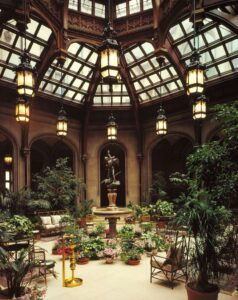In a world where wellness and sustainability reign supreme, the new symbol of refined living isn’t found in a home theater or subterranean wine cellar—it’s in the glass-encased serenity of an indoor greenhouse. Once known as conservatories, these elegant, light-filled spaces are making a striking return to high-end homes, not just as a nod to nature, but as a vital, beautiful extension of everyday life.
Historically, conservatories first rose to prominence in 17th-century Europe, where they served as status symbols for the elite. Originally built to protect citrus trees and exotic plants from harsh winters, these spaces quickly became architectural jewels—ornate glass structures attached to grand estates, often doubling as sunrooms or entertaining spaces. But as modern heating and air conditioning reshaped home design and our lifestyles became increasingly digital, conservatories faded from favor, dismissed as indulgent and impractical.
Now, they’re back—and with renewed purpose. Today’s indoor greenhouses are more than botanical showrooms. They’re multi-functional sanctuaries designed for mindful living. With climate-controlled glass walls, integrated irrigation systems, and seating areas nestled among palms and orchids, these green spaces are redefining luxury living from the inside out. It’s no longer just about displaying nature—it’s about living in it. Here, you can find stylish conservatory ideas for every kind of house.
Starting a personal indoor greenhouse offers numerous benefits beyond aesthetic appeal. It provides a year-round environment for nurturing plants that improve indoor air quality and create a calming atmosphere. Plants such as ferns, succulents, herbs, and tropical varieties thrive exceptionally well in these controlled conditions, requiring minimal maintenance thanks to automated watering and humidity controls. The ease of cultivating greenery indoors makes it accessible even for those new to gardening, turning plant care into a stress-relieving ritual rather than a chore.
 One of the most iconic examples of the conservatory’s enduring allure is the breathtaking Palm Court at the Biltmore Estate in Asheville, North Carolina. Built in the late 19th century, this grand conservatory was designed to shelter rare and exotic plants collected from around the world, serving as both a horticultural marvel and a place of refined leisure. Today, the Palm Court remains a stunning showcase of natural beauty and architectural elegance, with soaring glass ceilings and lush greenery framing elegant seating areas. It perfectly captures the spirit of the modern indoor greenhouse—where nature and comfort blend seamlessly to create an inviting sanctuary.
One of the most iconic examples of the conservatory’s enduring allure is the breathtaking Palm Court at the Biltmore Estate in Asheville, North Carolina. Built in the late 19th century, this grand conservatory was designed to shelter rare and exotic plants collected from around the world, serving as both a horticultural marvel and a place of refined leisure. Today, the Palm Court remains a stunning showcase of natural beauty and architectural elegance, with soaring glass ceilings and lush greenery framing elegant seating areas. It perfectly captures the spirit of the modern indoor greenhouse—where nature and comfort blend seamlessly to create an inviting sanctuary.
The resurgence of these lush indoor spaces is fueled by a growing desire for biophilic design—architecture that connects humans more deeply with the natural world. Studies show that exposure to greenery indoors boosts mood, focus, and even immunity. In luxury design, this translates into more than a few well-placed potted plants. Homeowners are embracing fully integrated indoor gardens as spaces to recharge, host, and find peace.
The New Eden isn’t about escaping the world; it’s about reconnecting with it—through design, through nature, and through intentional living. And in this new era of luxury, a room alive with light, plants, and presence may just be the most valuable one in the house.

